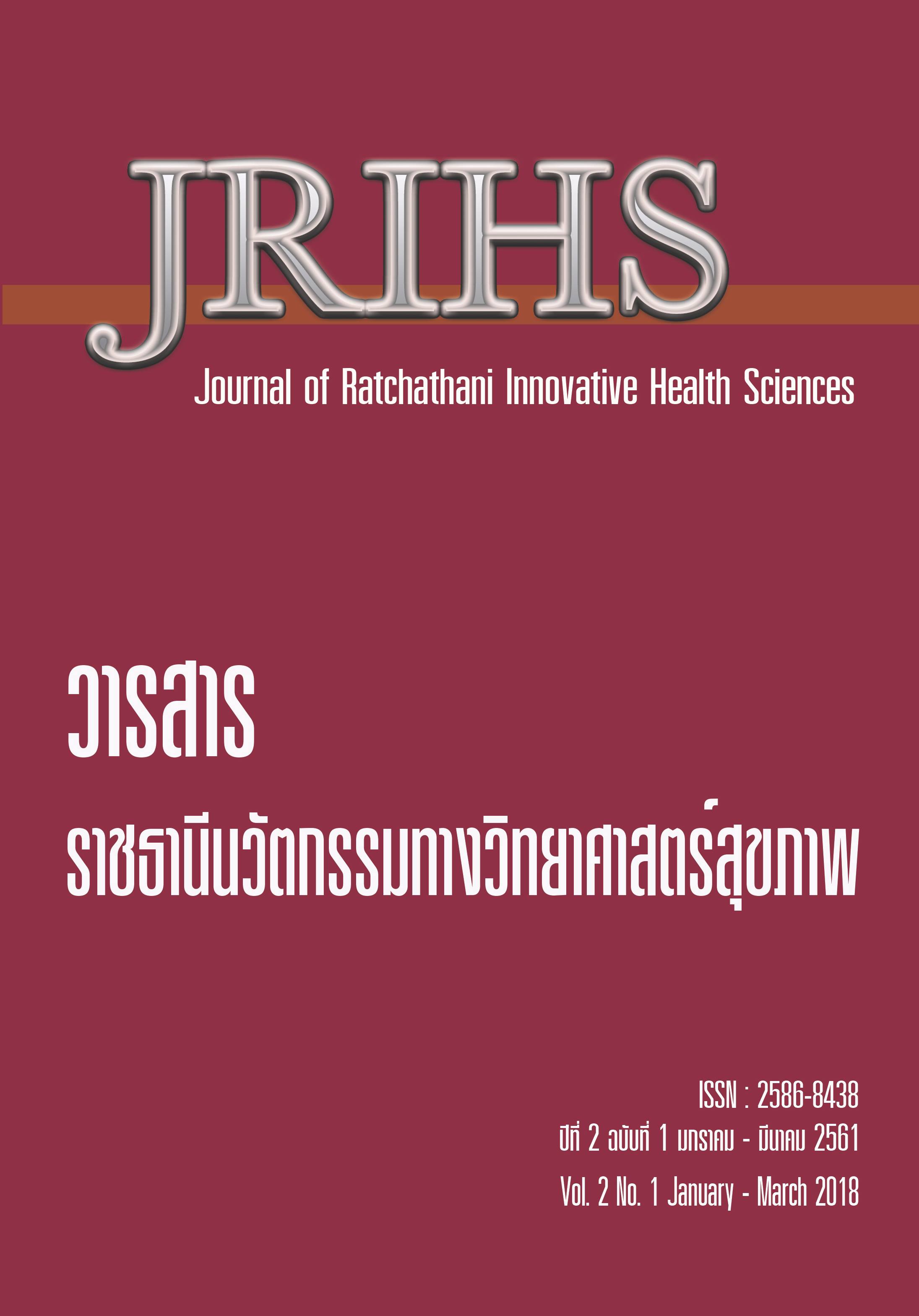Peripheral vein inflammation disease from intravenous solution in critical patient
Main Article Content
Abstract
This research is descriptive research The objective is to 1) Peripheral vein inflammation Rate in Critical patients 2) the demographic characteristics. Economy and society in Critical patients, Mukdahan Hospital. The study found that most of the samples received the intravenous solution is 64.0 percent male, female, 18 percent of people in the age range most 36.0 and 61–80 years of 38.0 percent. The age range is the 41-60 year of 26.0 percent to 62.0 percent of farming, 74.0 percent of elementary has a 35.0 percent, Spouse 70.0 percent, income between 3001–5000 baht/46.0 per cent, for most of diseases as heart disease, 40.0 percent. Cause illness, treatment, diseases of the respiratory system.34.0percent, Rights to treatment as universal coverage 32 percent. The rate of vein inflammation 14.0 per cent.
Article Details
ความคิดเห็นและข้อเสนอแนะใดๆ ที่นำเสนอในบทความเป็นของผู้เขียนแต่เพียงผู้เดียว โดยบรรณาธิการ กองบรรณาธิการ และคณะกรรมการวารสารราชธานีนวัตกรรมทางวิทยาศาสตร์สุขภาพไม่ได้มีส่วนเกี่ยวข้องแต่อย่างใด มหาวิทยาลัยราชธานี บรรณาธิการ และกองบรรณาธิการจะไม่รับผิดชอบต่อข้อผิดพลาดหรือผลที่เกิดขึ้น จากการใช้ข้อมูลที่ปรากฏในวารสารฉบับนี้
References
จงจิต หงส์เจริญ, และคณะ. (2551). ภาวะหลอดเลือดดำอักเสบและปัจจัยที่เกี่ยวข้องในผู้ป่วยศัลยกรรม ระบบทางเดินอาหารที่ได้รับสารน้ำทางหลอดเลือดดำส่วนปลาย. จุลสารชมรมควบคุมโรคติดเชื้อในโรงพยาบาลแห่งประเทศไทย, 18(1), 26-32.
ลักษณี มีนะนันท์. (2535). การให้สารน้ำทางหลอดเลือดดำ. ในสุปราณี วศินอมร (บรรณาธิการ),
การพยาบาลพื้นฐาน แนวคิดและการปฏิบัติ (น. 411-427) (พิมพ์ครั้งที่ 6). กรุงเทพฯ: จุดทองการพิมพ์.
สุจีรา จียาศักดิ์. (2524). เปรียบเทียบการเกิดหลอดเลือดดำอักเสบ เนื่องจากการให้สารน้ำโดยใช้เข็มและตำแหน่งที่แทงเข็มต่างกัน. (วิทยานิพนธ์ปริญญาวิทยาศาสตร์มหาบัณฑิต สาขาวิชาการพยาบาล บัณฑิตวิทยาลัย, มหาวิทยาลัยมหิดล).
สมหวัง ด่านชัยวิจิตร, (บรรณาธิการ). (2533). วิธีป้องกันโรคติดเชื้อในโรงพยาบาล. กรุงเทพฯ: เรือนแก้วการพิมพ์.
Batton, D.G., Maisels, M.J., & Appelbaum, P. (1982). Use of peripheral intravenous
cannulas in Premature Infants: a controlled study. Pediatrics, 70(3), 487-490.
Campos Oltra, J.R., Yunes Zarraga, J.L., & Villatoro, M.C. (1989). Analysis of the costs and complication of different procedures for the administration of intravenous liquids. Bol Med Hosp Infant Mex, 46(8), 547-453.
Collin, J., and Collin, C. (1975). Infusion thrombophebritis and infection with various canular. The lancet, 26(July), 150-152.
Faubion et al., 1986. WC Faubion, JR Wesley, N Khalidi, J Silva. (1986). Total parenteral nutrition catheter sepsis: Impact of the team approach. Journal of Parenteral and Nutrition.
Garland, J.S., et al. (1992). Peripheral intravenous catheter complications in critical ill children: a prospective study. Pediatrics, 89(6 Pt 2), 1145-1150.
Peter,G., L., loyd-Still, J.D., & Lovejoy, F.H. (1972). Local infection and bacteremia from scalp vein needles and polyethylene catheters in children.The Journal of Pediatrics, 80(1), 78-83.
Plumer, A.L. (1982). Principles and practice of intravenous therapy (3rd ed). Boston: Little, Brown and company.
Steele, J. (1996). Practical i.v. therapy (2nd ed). Pennsylvania: Springhouse.
Wynsma, L.A. (1998). Negative outcomes of intravasculae therapy in infants and children. AACN-Clin, 9(1), 49-63.
Yaowart, H.. (1998). Thai Journal of Pharmacology, May-Dec.Vol.20.


